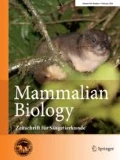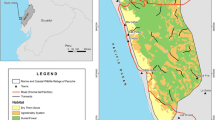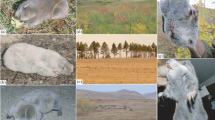Abstract
Tuco-tucos, South American rodents of the genus Ctenomys, is one of the most speciose genera among mammals. In this work, we performed a study of all extant Ctenomys species considering their conservation status and potential presence in Protected Areas, showing that 34 out of 67 (50.75%) species of tuco-tucos have significant overlapping distributions with such areas. We point out at-risk species that have no overlap with Protected Areas which deserve close surveillance and discuss the need for managing non-protected areas. We also assessed the identification at the species level of a previously unknown population of Ctenomys rionegrensis, an endangered species inhabiting sandy elevations in the Pre-Delta National Park, in Entre Ríos province, Argentina.




Similar content being viewed by others
Abbreviations
- PA:
-
Protected area
- PDNP:
-
Pre-Delta National Park
- DA:
-
Distribution area
- EOO:
-
Extent of occurrence
- AOO:
-
Area of occupancy
- VU:
-
Vulnerable
- EN:
-
Endangered
- CR:
-
Critically Endangered
- NT:
-
Nearly Threatened
- LC:
-
Least Concern
References
Administración de Parques Nacionales (2019) Sistema de Información de Biodiversidad. http://www.sib.gov.ar/ Accessed on 12 Apr 2019
Amori G, Esposito GA, Luiselli L (2016) Known from a handful of specimens: analyzing the worldwide patterns of occurrence and conservation of rodents and shrews recorded only from the type locality. J Threat Taxa 8:8556–8563
Beresford AE, Buchanan GM, Donald PF, Butchart SHM, Fishpool LDC, Rondinini C (2011) Poor overlap between the distribution of protected areas and globally threatened birds in Africa. Anim Conserv 14:99–107
Bidau CJ (2015) Family Ctenomyidae Lesson. In: Patton JL, Pardiñas UF, D’Elía G (eds) Mammals of South America, vol 2. rodents. University of Chicago Press, Chicago, pp 818–877
Bidau CJ (2016) Ctenomys haigi. The IUCN red list of threatened species 2016: e.T5807A22193246. http://dx.doi.org/10.2305/IUCN.UK.2016-2.RLTS.T5807A22193246.en. Downloaded on 06 September 2019
Bidau CJ (2018) Ctenomys rionegrensis. The IUCN red list of threatened species 2018: e.T136635A22193418. http://dx.doi.org/10.2305/IUCN.UK.2018-1.RLTS.T136635A22193418.en. Downloaded on 05 September 2019
Blainville HMD (1826) Sur une nouvelle espèce de Rongeur fouisseur du Brésil. Bulletin de la Societe philomathique de Paris 3:62–64
Bouckaert R, Heled J, Kühnert D, Vaughan T, Wu CH, Xie D, Suchard MA, Rambaut A, Drummond AJ (2014) BEAST 2: a software platform for Bayesian evolutionary analysis. PLoS Comput Biol 10(4):e1003537
Boyd C, Brooks TM, Butchart SH, Edgar GJ, Da Fonseca GA, Hawkins F, Van Dijk PP (2008) Spatial scale and the conservation of threatened species. Conserv Lett 1:37–43
Caraballo DA, Rossi MS (2018a) Integrative lineage delimitation in rodents of the Ctenomys Corrientes group. Mammalia 82:35–47
Caraballo DA, Rossi MS (2018b) Spatial and temporal divergence of the torquatus species group of the subterranean rodent Ctenomys. Contrib Zool 87:11–24
Caraballo DA, Abruzzese GA, Rossi MS (2012) Diversity of tuco-tucos (Ctenomys, Rodentia) in the Northeastern wetlands from Argentina: mitochondrial phylogeny and chromosomal evolution. Genetica 140:125–136
Caraballo DA, Tomasco IH, Campo DH, Rossi MS (2016) Phylogenetic relationships between tuco-tucos (Ctenomys, Rodentia) of the Corrientes group and the C. pearsoni complex. Mastozool Neotrop 23:39–49
Caraballo DA, Gómez Fernández MJ, Mirol PM, Rossi MS (2019) Ctenomys perrensi. In: Categorización 2019 de los mamíferos de Argentina según su riesgo de extinción. Lista Roja de los mamíferos de Argentina. Digital version: http://cma.sarem.org.ar
Chape S, Harrison J, Spalding M, Lysenko I (2005) Measuring the extent and effectiveness of protected areas as an indicator for meeting global biodiversity targets. Philos Trans R Soc Lond B Biol Sci 360:443–455. https://doi.org/10.1098/rstb.2004.1592
Contreras JR, Berry LM (1984) Una nueva especie del genero Ctenomys procedente de la provincia de Santa Fe (Rodentia, Ctenomyidae). Resumenes VII Jornadas Argentinas Zoologia, Mar del Plata 75
de Aguiar HJAC, Barros LAC, Alves DR, Mariano CDSF, Delabie JHC, das Graças Pompolo S (2017) Cytogenetic studies on populations of Camponotus rufipes (Fabricius, 1775) and Camponotus renggeri Emery, 1894 (Formicidae: Formicinae). PLoS One 12(5):e0177702
Dudley N (2008) Guidelines for applying protected area management categories. IUCN, Gland
Fornel R, Cordeiro-Estrela P, Freitas TRO (2018) Skull shape and size variation within and between mendocinus and torquatus groups in the genus Ctenomys (Rodentia: Ctenomyidae) in chromosomal polymorphism context. Genet Mol Biol 1:263–272
Fracchia S, Krapovickas L, Aranda-Rickert A, Valentinuzzi VS (2011) Dispersal of arbuscular mycorrhizal fungi and dark septate endophytes by Ctenomys cf. knighti (Rodentia) in the northern Monte Desert of Argentina. J Arid Environ 75:1016–1023
Freitas TRO (2016) Family Ctenomyidae (Tuco-tucos). In: Wilson DE, Lacher TE, Mittermeier RA (Org.) Handbook of the mammals of the world—Volume 6 Lagomorphs and Rodents I. 1 edn, vol 6. Lynx Edicions Publications, Barcelona 2016, pp 498–534
Freitas TRO, Fernandes FA, Fornel R, Roratto PA (2012) An endemic new species of tuco-tuco, genus Ctenomys (Rodentia: Ctenomyidae), with a restricted geographic distribution in southern Brazil. J Mammal 93:1355–1367
Galiano D, Bernardo-Silva J, Freitas TRO (2014) Genetic pool information reflects highly suitable areas: the case of two parapatric endangered species of tuco-tucos (Rodentia: Ctenomiydae). PLoS ONE 9:e97301
Gallardo MH, Kohler N, Araneda C (1996) Loss of genetic variation in Ctenomys coyhaiquensis (Rodentia, Ctenomyidae) affected by vulcanism. Mastozool Neotrop 3:7–13
Gardner SL, Salazar-Bravo J, Cook JA (2014) New species of Ctenomys Blainville, 1826 (Rodentia: Ctenomyidae) from the Central Valleys of Bolivia. Special Publications of the Museum of Texas Tech University 62
Giménez MD, Bidau CJ, Argüelles CF, Contreras JR (1999) Chromosomal characterization and relationship between two new species of Ctenomys (Rodentia, Ctenomyidae) from northern Córdoba province. Argentina Z Säugetierkd 64:91–106
Gómez Fernández MJ, Boston ES, Gaggiotti OE, Kittlein MJ, Mirol PM (2016) Influence of environmental heterogeneity on the distribution and persistence of a subterranean rodent in a highly unstable landscape. Genetica 144:711–722
Gómez Fernández MJ, Mirol PM, Rossi MS, Caraballo DA (2019) Ctenomys dorbignyi. In: Categorización 2019 de los mamíferos de Argentina según su riesgo de extinción. Lista Roja de los mamíferos de Argentina. Digital version: http://cma.sarem.org.ar
Gómez Fernández MJ, Mirol PM, Rossi MS, Caraballo DA (2019) Ctenomys roigi. In: Categorización 2019 de los mamíferos de Argentina según su riesgo de extinción. Lista Roja de los mamíferos de Argentina. Digital version: http://cma.sarem.org.ar
Halladay P, Gilmour DA (1995) Conserving biodiversity outside protected areas: the role of traditional agro-ecosystems. IUCN, Gland
Isaac NJ, Mallet J, Mace GM (2004) Taxonomic inflation: its influence on macroecology and conservation. Trends Ecol Evol 19:464–469
IUCN (2012) IUCN red list categories and criteria: version 3.1. Second edition. IUCN, Cambridge. www.iucnredlist.org/technical-documents/categoriesand-criteria
IUCN, 2019. The IUCN Red List of Threatened Species. 2019-1. https://www.iucnredlist.org. Downloaded on 31-03-2019
IUCN Standards and Petitions Subcommittee (2017) Guidelines for IUCN red list categories and criteria. Version 13. Prepared by the Standard Petitions Subcommittee. http://www.iucnredlist.org/documents/RedListGuidelines.pdf
IUCN and UNEP-WCMC, 2019. The World Database on Protected Areas (WDPA) [On-line], [April 2019]. UNEP-WCMC, Cambridge. https://www.protectedplanet.net
Jetz W, Sekercioglu CH, Watson JE (2008) Ecological correlates and conservation implications of overestimating species geographic ranges. Conserv Biol 22:110–119
Joppa LN, Loarie SR, Pimm SL (2008) On the protection of ‘‘protected areas’’. Proc Natl Acad Sci USA 105:6673–6678
King M (1993) Species evolution. The Role of Chromosome Change. Cambridge University Press, Cambridge
Kubiak BB, Gutiérrez EE, Galiano D, Maestri R, Freitas TR (2017) Can niche modeling and geometric morphometrics document competitive exclusion in a pair of subterranean rodents (Genus Ctenomys) with tiny parapatric distributions? Sci Rep 7:16283
Lacey EA, Patton JL, Cameron GN (2000) Life underground: the biology of subterranean rodents. University of Chicago Press, Chicago
Langguth A, Abella A (1970) Las especies uruguayas del genero Ctenomys. Com Zool Mus Hist Nat Montevideo 10:1–27
Lazo-Cancino D, Rivera R, Paulsen-Cortez K, González-Berríos N, Rodríguez-Gutiérrez R, Rodríguez-Serrano E (2019) The impacts of climate change on the habitat distribution of the vulnerable Patagonian-Fueguian species Ctenomys magellanicus (Rodentia. Ctenomyidae), J Arid Environ, p 104016
Lessa EP, Langguth A (1983) Ctenomys pearsoni, n. sp. (Rodentia: Octodontidae), del Uruguay. Resúmenes y Comuni- ciones de las Jornadas de Ciencias Naturales del Uruguay 3:86–88
Londoño-Gaviria M, Teta P, Ríos SD, Patterson BD (2019) Redescription and phylogenetic position of Ctenomys dorsalis Thomas 1900, an enigmatic tuco tuco (Rodentia, Ctenomyidae) from the Paraguayan Chaco. Mammalia 83:227–236
Lopes CM, Freitas TRO (2012) Human impact in naturally patched small populations: genetic structure and conservation of the burrowing rodent, tuco-tuco (Ctenomys lami). J Hered 103:672–681
Lopoukhine N, de Souza Dias F (2012) What does target 11 really mean? PARKS 18:5–8
Mapelli FJ, Mora MS, Mirol PM, Kittlein MJ (2012) Population structure and landscape genetics in the endangered subterranean rodent Ctenomys porteousi. Conserv Genet 13:165–181
Miranda V, Rothen C, Yela N, Aranda-Rickert A, Barros J, Calcagno J, Fracchia S (2019) Subterranean desert rodents (Genus Ctenomys) create soil patches enriched in root endophytic fungal propagules. Microb Ecol 77:451–459
Mora MS, Cutrera AP, Lessa EP, Vassallo AI, D’anatro A, Mapelli FJ (2013) Phylogeography and population genetic structure of the Talas tuco-tuco (Ctenomys talarum): integrating demographic and habitat histories. J Mammal 94:459–476
Nagendra H (2008) Do Parks Work? Impact of protected areas on land cover clearing. AMBIO: A J Hum Environ 37:330–337
Nylander J (2004) MrModeltest v2. Program distributed by the author. Evolutionary Biology Centre, Uppsala University, Uppsala
Ortells MO (1995) Phylogenetic analysis of G-banded karyotypes among the South American subterranean rodents of the genus Ctenomys (Caviomorpha: Octodontidae), with special reference to chromosomal evolution and speciation. Biol J Linn Soc 54:43–70
Ortells MO, Contreras JR, Reig OA (1990) New Ctenomys karyotypes (Rodentia, Octodontidae) from north-eastern Argentina and from Paraguay confirm the extreme chromosomal multiformity of the genus. Genetica 82:189–201
Parada A, D’Elía G, Bidau CJ, Lessa EP (2011) Species groups and the evolutionary diversification of tuco-tucos, genus Ctenomys (Rodentia: Ctenomyidae). J Mammal 92:671–682
Pautasso AA, Fandiño B (2008) Tuco-Tuco Santafesino ”Ctenomys yolandae”. Mamíferos de la provincia de Santa Fé, Argentina. Comunicaciones del Museo Provincial de Ciencias Naturales “Florentino Ameghino” 13:1-248
Pebesma E (2018) Simple features for R: standardized support for spatial vector Data. R J. https://journal.r-project.org/archive/2018/RJ-2018-009/
Phosri C, Rodríguez A, Sanders IR, Jeffries P (2010) The role of mycorrhizas in more sustainable oil palm cultivation. Agric Ecosyst Environ 135:187–193
Quantum GIS Development Team (2016) QGIS geographic information system. Open Source Geospatial Foundation Project. http://qgis.osgeo.org
R Team (2015) RStudio: integrated development for R. R. Studio, Inc., Boston, vol 42, pp 14. http://www.rstudio.com
R Core Team (2017) R: a language and environment for statistical computing. R Foundation for Statistical Computing, Vienna
Rambaut A, Suchard MA, Xie D, Drummond AJ (2014) Tracer v1.6. http://beast.bio.ed.ac.uk/Tracer
Ramos-Zapata J, Orellana R, Guadarrama P, Medina-Peralta S (2009) Contribution of mycorrhizae to early growth and phosphorus uptake by a neotropical palm. J Plant Nutr 32:855–866
Reichman OJ, Seabloom EW (2002) The role of pocket gophers as subterranean ecosystem engineers. Trends Ecol Evol 17:44–49
Reig OA, Kiblisky P (1969) Chromosome multiformity in the genus Ctenomys (Rodentia, Octodontidae). A progress report. Chromosoma 28:211–244
Reig OA, Busch C, Ortells MO, Contreras JR (1990) An overview of evolution, systematics, population biology, cytogenetics, molecular biology and speciation in Ctenomys. In: Nevo E, Reig OA (eds) Evolutionary biology of subterranean mammals. Alan R. Liss, New York, pp 71–96
Rodrigues ASL, Andelman SJ, Bakarr MI, Boitani L, Brooks TM, Cowling RM, Yan X (2004) Effectiveness of the global protected area network in representing species diversity. Nature 428:640–643
Rondinini C, Stuart S, Boitani L (2005) Habitat suitability models and the shortfall in conservation planning for African vertebrates. Conserv Biol 19:1488–1497
Rondinini C, Wilson KA, Boitani L, Grantham H, Possingham HP (2006) Tradeoffs of different types of species occurrence data for use in systematic conservation planning. Ecol Lett 9:1136–1145
Roratto PA, Fernandes FA, Freitas TRO (2015) Phylogeography of the subterranean rodent Ctenomys torquatus: an evaluation of the riverine barrier hypothesis. J Biogeogr 42:694–705
Sánchez TR, Tomasco IH, Díaz MM, Bárquez RM (2019) Contribution to the knowledge of the rare “Famatina tuco-tuco”, Ctenomys famosus Thomas 1920 (Rodentia: Ctenomyidae). Mammalia 83:11–22
Sikes RS, Gannon WL (2011) Guidelines of the American Society of Mammalogists for the use of wild mammals in research. J Mammal 92:235–253
Stolz JFB, Gonçalves GL, Leipnitz L, Freitas TRO (2013) DNA-based and geometric morphometric analysis to validate species designation: a case study of the subterranean rodent Ctenomys bicolor. Genet Mol Res 12:5023–5037
Tamura K, Stecher G, Peterson D, Filipski A, Kumar S (2013) MEGA6: molecular evolutionary genetics analysis version 6.0. Mol Biol Evol 30:2725–2729
Tattersall I (2007) Madagascar’s lemurs: cryptic diversity or taxonomic inflation? Evol Anthropol 16:12–23
Teta PV, D’Elía G (2019) The least known with the smallest ranges: analyzing the patterns of occurrence and conservation of South American rodents known only from their type localities. Therya. https://doi.org/10.12933/therya-19886(ISSN 2007-3364)
Teta PV, Ríos S (2017) Ctenomys conoveri Osgood, 1946 (Rodentia, Ctenomyidae), un nuevo mamífero para Argentina; Museo Nacional de Historia Natural del Paraguay. Boletín del Museo Nacional de Historia Natural del Paraguay 21:67–93
Tomasco IH, Caraballo DA (2019) Ctenomys pearsoni. In: Categorización 2019 de los mamíferos de Argentina según su riesgo de extinción. Lista Roja de los mamíferos de Argentina. Digital version: http://cma.sarem.org.ar
Tomasco IH, Caraballo DA (2019) Ctenomys rionegrensis. In: Categorización 2019 de los mamíferos de Argentina según su riesgo de extinción. Lista Roja de los mamíferos de Argentina. Digital version: http://cma.sarem.org.ar
Upham NS, Patterson BD (2015) Evolution of the caviomorph rodents: a complete phylogeny and timetree of living genera. In: Vassallo AI, Antenucci D (eds) Biology of caviomorph rodents: diversity and evolution, 1st edn. SAREM Series A, Buenos Aires, pp 63–120
Vitullo AD, Roldan ERS, Merani MS (1988) On the morphology of spermatozoa of tuco-tucos, Ctenomys (Rodentia: Ctenomyidae): new data and its implications for the evolution of the genus. J Zool 215:675–683
Wlasiuk G, Garza JC, Lessa EP (2003) Genetic and geographic differentiation in the Rio Negro tuco-tuco (Ctenomys rionegrensis): inferring the roles of migration and drift from multiple genetic markers. Evolution 57:913–926
Woods C, Kilpatrick C (2005) Infraorder Hystricognathi Brandt, 1855. In: Wilson DE, Reeder DM (eds) Mammal species of the world: a taxonomic and geographic reference. John Hopkins University Press, Baltimore, pp 1538–1600
Acknowledgements
The authors would like to thank the staff of the Museo Provincial de Ciencias Naturales Florentino Ameghino (Santa Fé, Argentina) and from the Museo Argentino de Ciencias Naturales Bernardino Rivadavia (Buenos Aires, Argentina) for facilitating the collected material, and for their selfless disposition. We would also like to thank Bruno Busnello Kubiak, Carla Martins Lopes and Daniel Galiano for the invaluable help in the evaluation of Brazilian species distributions. We would like to thank Enrique Rodríguez for providing a rational criterion to discuss the distribution of C. magellanicus. We are grateful to the Editor and two anonymous reviewers for their suggestions which have improved the manuscript. DAC and AAC would like to thank Gastón Lo Coco who put us in contact and made possible the collaboration which originated this study. AAC would like to thank his family, Antonella, Natacha and Braian for their company and support. DAC and SLL would like to thank Mirta Fasolino and Dante Caraballo for their invaluable support. MSR is career investigator of CONICET, Argentina.
Funding
This research did not receive any specific grant from funding agencies in the public, commercial, or not-for-profit sectors.
Author information
Authors and Affiliations
Corresponding author
Ethics declarations
Conflict of interest
The authors declare that they have no conflict of interest.
Additional information
Publisher's Note
Springer Nature remains neutral with regard to jurisdictional claims in published maps and institutional affiliations.
Handling editor: Eva Bärmann.
Electronic supplementary material
Below is the link to the electronic supplementary material.
Supplementary Table
1. List of all Protected Areas overlapped with Ctenomys species. (XLSX 412 kb)
Supplementary Table
2. Classification, DNA sequence accession numbers, and cyt-b coding sequence length of all samples used in this study. (XLSX 15 kb)
Supplementary File 1
. Shapes of Ctenomys dorbignyi, C. perrensi, C. roigi, C. pearsoni and C. rionegrensis based on a recent assessment coordinated by the Argentinean Society for the Study of Mammals (SAREM) and the National Ministry of Environment and Sustainable Development (MAyDS), in which DAC and MSR have taken part. (PDF 531 kb)
Supplementary File 2
. Cytochrome b nucleotide alignment of 103 Ctenomys and 3 outgroup sequences used in the phylogenetic analysis.
Supplementary File 3. Cytochrome b nucleotide alignment of 103 Ctenomys, 2 partial sequences of C. yolandae and 3 outgroup sequences used in the phylogenetic analysis. (ZIP 16 kb)
Supplementary Figure
1. Pelage patterns of a) Ctenomys rionegrensis. Specimens deposited at the Museo Nacional de Ciencias Naturales Bernardino Rivadavia, Ciudad de Buenos Aires, Argentina. b) Ctenomys rionegrensis. Specimen captured and released at the Pre-Delta National Park. c) Ctenomys yolandae. Specimens (N°182, 699, 455, 696) deposited in the Museo Florentino Ameghino, Santa Fe, Argentina. (PDF 304 kb)
Supplementary Online Material
1. Interactive map showing Ctenomys Distribution Areas (DAs), Protected Areas (PAs) and their intersection. To avoid an excessively large file, we retained PAs within the limtis of the distribution of the genus (RAR 10,904 kb)
Rights and permissions
About this article
Cite this article
Caraballo, D.A., López, S.L., Carmarán, A.A. et al. Conservation status, protected area coverage of Ctenomys (Rodentia, Ctenomyidae) species and molecular identification of a population in a national park. Mamm Biol 100, 33–47 (2020). https://doi.org/10.1007/s42991-019-00004-x
Received:
Accepted:
Published:
Issue Date:
DOI: https://doi.org/10.1007/s42991-019-00004-x




